Introduction
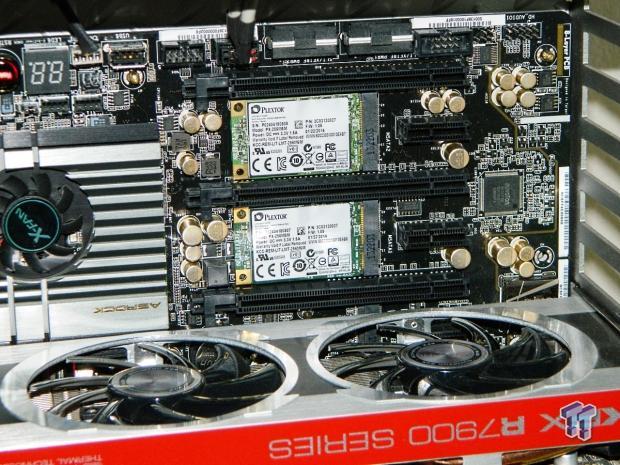
M.2 is destined to supplant mSATA in the near future. Right now, however, mSATA has something to offer that is not available from M.2 devices: bootable RAID 0. The M5M is most similar to Plextor's M5 Pro Xtreme, utilizing the same Marvell 88SS9187 controller, 19nm Toshiba flash, and firmware. Plextor's M5 Pro Xtreme is a decent performer in its standard 2.5-inch form, and today we're going to see what the mSATA version of Plextor's M5 series can deliver in RAID 0.
As you might imagine, mSATA SSDs typically do not have nearly the number of flash packages as their 2.5-inch counterparts. This reduction in the number of flash packages reduces the drive's parallelism (NAND channels), which in turn reduces a typical mSATA SSD's sequential and random write performance in comparison to its 2.5-inch counterparts. Random read performance (IOPS) takes a hit from a reduced number of NAND channels; however, sequential read performance is not affected.
As you can see in the above picture, there is nothing quite as slick as a couple of tiny, high-performance SSDs that mount directly to a motherboard with no power or data cables required. Plextor's M5M mSATA SSDs compete in the same consumer space as Samsung's EVO mSATA SSDs. Competing with EVO mSATA SSD's performance and price is a tall order, with the M5M's redeeming feature being its superior quality flash.
Plextor's M5 series is not a new SSD. Plextor recently launched their new M6 series SSDs, although from what I've seen, the M5 is every bit as fast as the M6. The way I see it, you are better off purchasing an M5 for a lower cost.

At TweakTown, we take no prisoners, and as such, we are tossing our M5M 256GB 2-drive mSATA array into the ring with the very best arrays we have. Let's see what happens.
PRICING: You can find Plextor's M5M (256GB) for sale below. The prices listed are valid at the time of writing but can change at any time. Click the link to see the very latest pricing for the best deal.
United States: The Plextor M5M (256GB) retails for $179.86 at Amazon.
Canada: The Plexor M5M (256GB) retails for CDN$246.88 at Amazon Canada.
Specifications, Drive Details, Test System Setup, Drive Properties, Pricing and Availability
Specifications

Plextor's M5M Series mSATA SATA III SSD is available in three capacity sizes: 64GB, 128GB, and 256GB. Specifications list the 256GB M5M as having a bandwidth performance of up to 540 MB/s sequential read and up to 430 MB/s sequential write. 4kB random read performance is listed at up to 79,000 IOPS, and 4kB random write performance is listed at up to 77,000 IOPS. Plextor guarantees its M5M series for an industry-standard 3 years.
Because this is a RAID review, we are going to focus on performance rather than features. For a more in-depth look at the Plextor M5M's feature set, I will refer you to Chris Ramseyer's extensive review of Plextor's M5M mSATA Series SSD.
Drive Details – Plextor M5M 256GB mSATA SSD
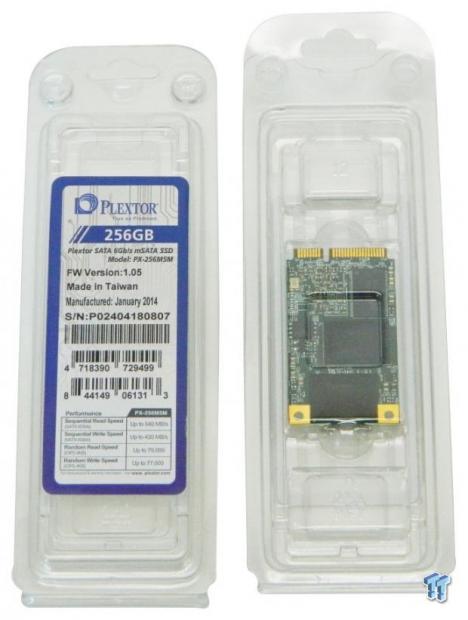
Plextor packages its M5M in a clear plastic clamshell container. There is a manufacturer's sticker on top of the container that advertises the drive's capacity, date of manufacture, and performance metrics.

This side of the drive's tiny PCB has a manufacturer's sticker that lists the drive's capacity, shipping firmware, model number, serial number, and various relevant pieces of information. Under this sticker is the drive's Marvell 88SS9187 flash controller and two 64GB 19nm Toshiba flash packages.

On this side of the drive's PCB, we find two more flash packages, a 512MB DDR3-1333 DRAM package, and a firmware chip.
Test System Setup
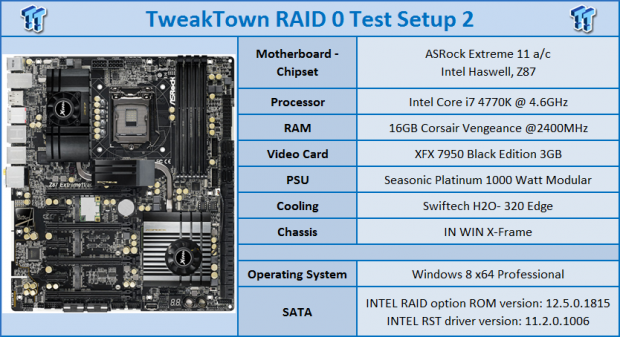
- Drive Properties

The majority of our testing is performed with our test drive/array as our boot volume. Our boot volume is 75 percent full for all OS Disk "C" drive testing to mimic a typical consumer OS volume implementation. We are using 64k stripes for our 2-3 drive arrays and 32k stripes for our 4-6 drive arrays. Write caching is enabled, and Windows buffer flushing is disabled.
All of our testing includes charting the performance of a single drive as well as RAID 0 arrays of our test subjects. We are utilizing Windows 8.1 64-bit for all of our testing.
PRICING: You can find Plextor's M5M (256GB) for sale below. The prices listed are valid at the time of writing but can change at any time. Click the link to see the very latest pricing for the best deal.
United States: The Plextor M5M (256GB) retails for $179.86 at Amazon.
Canada: The Plexor M5M (256GB) retails for CDN$246.88 at Amazon Canada.
Synthetic Benchmarks – ATTO, Anvil Storage Utilities, CrystalDiskMark & AS SSD
ATTO
Version and / or Patch Used: 2.47
ATTO is a timeless benchmark used to provide manufacturers with data used for marketing storage products.

Read transfers max out at 1.018 GB/s, while write transfers max out at 0.807 GB/s.
Sequential Write

Sequential write transfers ramp up faster than the rest of the arrays on our chart.
Sequential Read
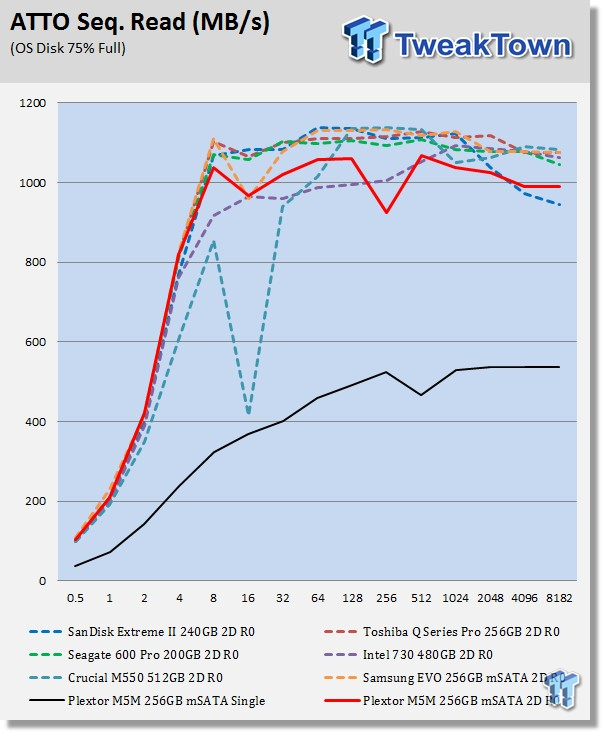
Sequential read transfers ramp up quickly, but finish second to last.
Anvil Storage Utilities
Version and / or Patch Used: RC6
Anvil's Storage Utilities is a storage benchmark designed to measure the storage performance of SSDs. The Standard Storage Benchmark performs a series of tests; you can run a full test or just the read or write test, or you can run a single test, i.e. 4k QD16.

8500 points is good performance. It's even better when you consider these drives are handicapped by a lack of NAND channeling.
Read IOPS through Queue Depth Scale
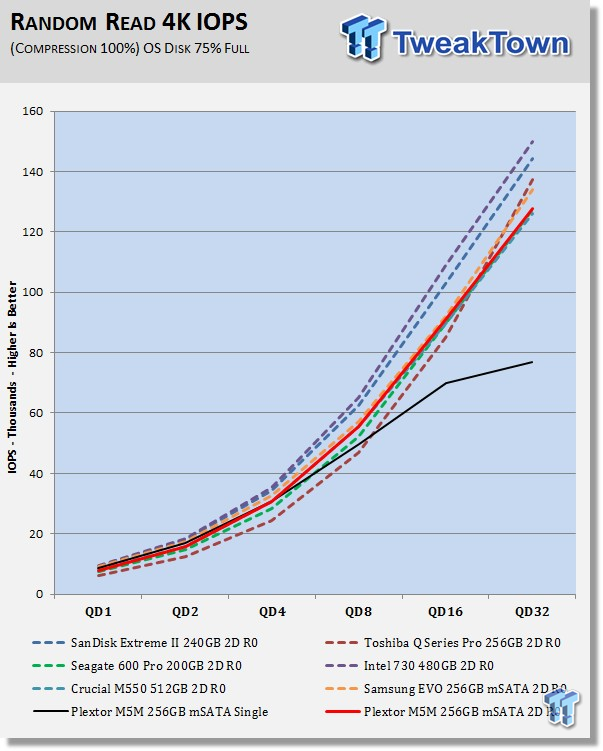
Read performance is lower than most of the arrays on our chart.
Write IOPS through Queue Scale

A lack of NAND channeling is delivering lower than average write performance. Samsung's mSATA EVO, with its "Turbo Write" technology, writes much faster as long as the amount of data being written fits within the EVO's emulated SLC layer.
CrystalDiskMark
Version and / or Patch Used: 3.0 Technical Preview
CrystalDiskMark is disk benchmark software that allows us to benchmark 4k and 4k queue depths with accuracy.
Note: Crystal Disk Mark 3.0 Technical Preview was used for these tests since it offers the ability to measure native command queuing at 4 and 32.

Overall, a very good performance.

4k:QD32 read performance is excellent, surpassing our mSATA EVO array.

Write performance overall is below average; however, our M5M array has excellent 4k:QD4 performance.
AS SSD
Version and / or Patch Used: 1.7.4739.38088
AS SSD determines the performance of Solid-State Drives (SSD). The tool contains four synthetic as well as three practice tests. The synthetic tests are to determine the sequential and random read and write performance of the SSD.


With the last of our synthetic testing completed, let's move to our light usage model testing to give us a better idea of what's under the hood of our M5M array.
Benchmarks (Trace Based OS Volume) - PCMark Vantage, PCMark 7 & PCMark 8
Light Usage Model
We are going to categorize these tests as indicative of a light workload. If you utilize your computer for light workloads like browsing the web, checking emails, light gaming, and office related tasks, then this category of results is most relevant for your needs.
PCMark Vantage - Hard Disk Tests
Version and / or Patch Used: 1.2.0.0
The reason we like PCMark Vantage is because the recorded traces are played back without system stops. What we see is the raw performance of the drive. This allows us to see a marked difference between scoring that other trace-based benchmarks do not exhibit. An example of a marked difference in scoring on the same drive would be empty versus filled versus steady state.
We run Vantage three ways. The first run is with the OS drive/Array 75 percent full to simulate a lightly used OS volume filled with data to an amount we feel is common for most users. The second run is with the OS volume written into a "Steady State" utilizing SNIA's guidelines (Rev 1.1). Steady state testing simulates a drive/array's performance similar to that of a drive/array that has been subjected to consumer workloads for extensive amounts of time. The third run is a Vantage HDD test with the test drive/array attached as an empty, lightly used secondary device.
OS Volume 75% Full - Lightly Used

OS Volume 75% Full - Steady State

Secondary Volume Empty - Lightly Used

As you can see, there's a big difference between an empty drive/array, one that's 75% full/used, and one that's in a steady state.
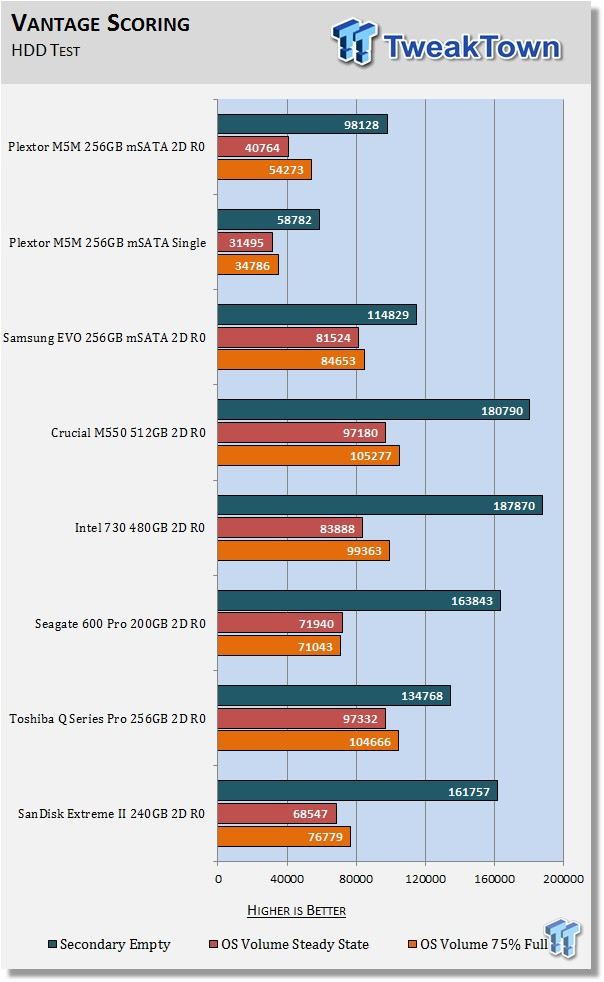
The important scores to pay attention to are "OS Volume Steady State" and "OS Volume 75% full." These two categories are most important because they are indicative of typical of consumer user states.
When a drive/array is in a steady state, it means garbage collection is running at the same time it's reading/writing. There is a huge difference in performance between a single drive and a 2-drive array.
Our M5M array's workload performance is substandard.
PCMark 7 - System Storage
Version and / or Patch Used: 1.4.00
We will look to the Raw System Storage scoring for RAID 0 evaluations because it's done without system stops and therefore allows us to see significant scoring differences between drives/arrays.
OS Volume 75% Full - Lightly Used


Workloads are not the strong suit of the M5M.
PCMark 8 - Storage Bandwidth
Version and / or Patch Used: 1.2.157
We use the PCMark 8 Storage benchmark to test the performance of SSDs, HDDs, and hybrid drives with traces recorded from Adobe Creative Suite, Microsoft Office, and a selection of popular games. You can test the system drive or any other recognized storage device, including local external drives. Unlike synthetic storage tests, the PCMark 8 Storage benchmark highlights real-world performance differences between storage devices.
OS Volume 75% Full - Lightly Used


IMFT flash based arrays dominate this testing. The M5M's NAND channeling, which is equivalent to a 4-channel controller, is again outpaced by the rest of our arrays.
Benchmarks (Secondary Volume) – Disk Response & Transfer Rates
Iometer – Disk Response
Version and / or Patch Used: 1.1.0
We use Iometer to measure disk response times. Disk response times are measured at an industry-accepted standard of 4k QD1 for both write and read. Each test is run twice for 30 seconds consecutively, with a 5 second ramp-up before each test. The drive/array is partitioned and attached as a secondary device for this testing.
Write Response

Read Response

Average Disk Response
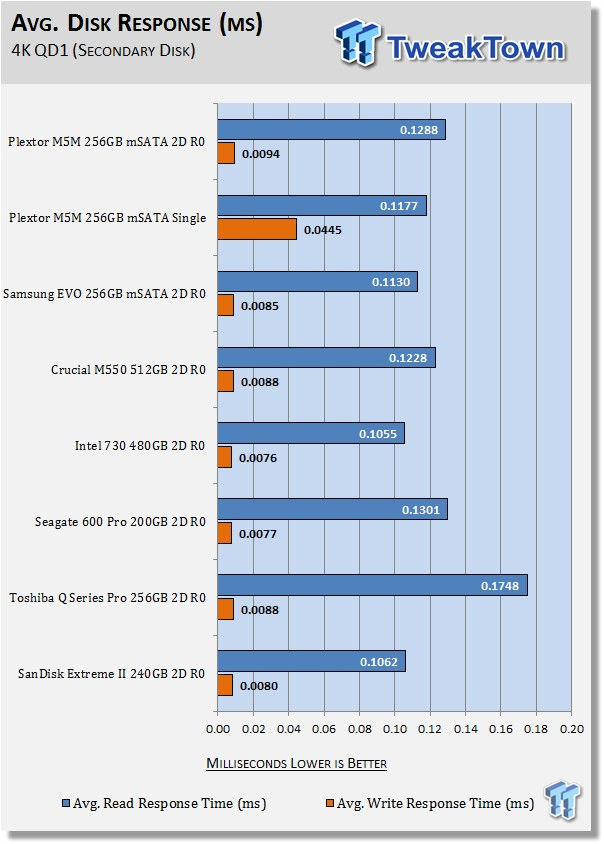
Write response times benefit most from RAID 0 because of write caching. There is a slight latency increase in read response times for an array versus a single drive.
DiskBench ? Directory Copy
Version and / or Patch Used: 2.6.2.0
We use DiskBench to time a 28.6GB block (9,882 files in 1,247 folders) of mostly incompressible random data as it's transferred from our OS array to our test drive/array. We then read from a 6GB zip file that's part of our 28.6GB data block to determine the test drive/array's read transfer rate. The system is restarted prior to the read test to clear any cached data, ensuring an accurate test result.
Write Transfer Rate

Read Transfer Rate


Finally our M5M array redeems itself. Most notable, we can see that the M5M has superior flash in comparison to our EVO array, and as such, it has superior write transfer performance to go along with its vastly superior endurance capabilities.
Benchmarks (Secondary Volume) – PCMark 8 Extended
Futuremark PCMark 8 Extended – Consistency Test
Heavy Usage Model
We consider PCMark 8's consistency test to be our heavy usage model test. This is the usage model most enthusiasts, heavy duty gamers, and professionals fall into. If you do a lot of gaming, audio/video processing, rendering, or have workloads of this nature, then this test will be most relevant to you.
PCMark 8 has built-in, command line executed storage testing. The PCMark 8 Consistency test measures the performance consistency and the degradation tendency of a storage system.
The Storage test workloads are repeated. Between each repetition, the storage system is bombarded with a usage that causes degraded drive performance. In the first part of the test, the cycle continues until a steady degraded level of performance has been reached. (Steady State)
In the second part, the recovery of the system is tested by allowing the system to idle and measuring the performance with long intervals. (TRIM)
The test reports the performance level at the start, the degraded steady state, and the recovered state, as well as the number of iterations required to reach the degraded state and the recovered state.
We feel Futuremark's Consistency Test is the best test ever devised to show the true performance of solid state storage in a heavy usage scenario. This test takes on average 13-17 hours to complete, and it writes somewhere between 450GB and 8000GB of test data, depending on the drive(s) being tested. If you want to know what an SSD's performance is going to look like after a few months or years of heavy usage, this test will show you.
Here's a breakdown of Futuremark's Consistency Test:
Precondition phase:
1. Write to the drive sequentially through up to the reported capacity with random data.
2. Write the drive through a second time (to take care of overprovisioning).
Degradation phase:
1. Run writes of random size between 8*512 and 2048*512 bytes on random offsets for 10 minutes.
2. Run performance test (one pass only).
3. Repeat 1 and 2 for 8 times, and on each pass increase the duration of random writes by 5 minutes.
Steady state phase:
1. Run writes of random size between 8*512 and 2048*512 bytes on random offsets for 50 minutes.
2. Run performance test (one pass only).
3. Repeat 1 and 2 for 5 times.
Recovery phase:
1. Idle for 5 minutes.
2. Run performance test (one pass only).
3. Repeat 1 and 2 for 5 times.
Storage Bandwidth
PCMark 8's Consistency test provides a ton of data output that we can use to judge a drive's performance.

We consider steady state bandwidth (the blue bar) our test that carries the most weight in ranking a drive's performance. The reason we consider steady state performance as more important than TRIM is that when you are running a heavy-duty workload, TRIM will not be occurring while that workload is being executed. TRIM performance (the orange and red bars) is what we consider the second most important consideration when ranking a drive's performance. Trace-based consistency testing is where true high performing SSDs are separated from the rest of the pack.
Plextor drives really crumble in a heavy-duty usage environment, and our M5M array is no exception. Our M5M array performs similarly to our 840 Pro array that we retired from this test due to its inferior performance. Our M5M array does outperform the dual controller equipped ASUS RAIDr PCIe card.

We chart our test subject's storage bandwidth as reported at each of the test's 18 trace iterations. This gives us a good visual perspective of how our test subjects perform as testing progresses.
Total Access Time (Latency)
Access time is the time delay or latency between a request to an electronic system and the access being completed or the requested data returned. Access time is how long it takes to get data back from the disk. We chart the total time the disk is accessed as reported at each of the test's 18 trace iterations.

A visual perspective of our M5M array's performance just reinforces that if you are a heavy-duty user, then an M5M is not the drive/array for you.
Disk Busy Time
Disk Busy Time is how long the disk is busy working. We chart the total time the disk is working as reported at each of the tests 18 trace iterations.

When latency is high, disk busy time is high as well. This time even the RAIDr PCIe card outperforms our M5M array.
Data Written
We measure the total amount of random data that the drives are capable of writing during the degradation phases of the consistency test. The total combined time that degradation data is written to the drives is 470 minutes. This can be very telling. The better the drives can process a continuous stream of random data, the more data will be written.
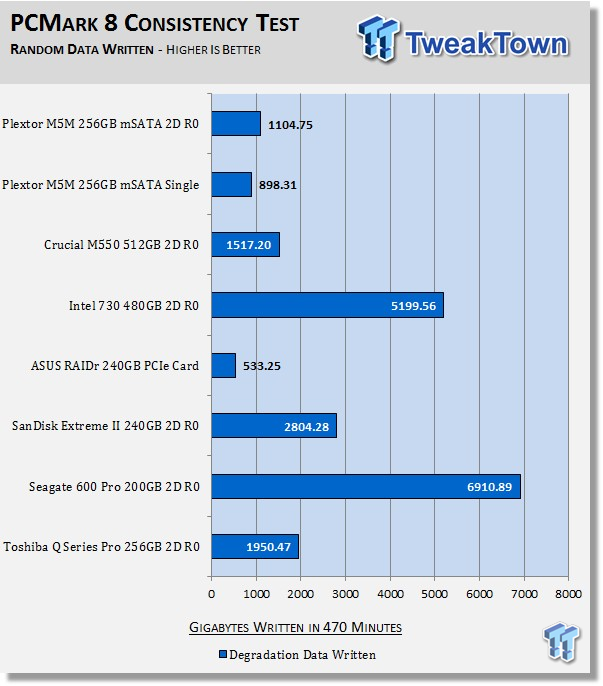
This test cements our M5M array's victory over the RAIDr PCIe card, as well as it cements the fact that you do not want an M5M for a heavy usage scenario.
Final Thoughts

Solid state storage is the most important performance component found in a modern system today. Without it, you do not even have a performance system.
We tossed Plextor's M5M 256 mSATA SSD into the ring with the fastest SSDs on the market today. Our M5M array was able to hold its own in a light usage scenario, but crumbled when subjected to our heavy duty usage testing.
It is fair to say that the M5M was never designed to perform in a heavy usage scenario simply because it's designed for laptop usage more than anything else. As a laptop SSD, in a light usage scenario, the M5M will serve you well. A desktop implementation of the M5M in an enthusiast setting is really out of the question.
Keep in mind that even though the M5M in an OS environment can barely hold its head above water in comparison to the leading SSDs on the market, it will still provide you with performance on an order of magnitude better than any SSHD or HDD; so, in that respect, there is definitely a viable market for the M5M, provided the price is right.
If you plan on using your M5M as a secondary device, e.g. in that unused mSATA slot on your laptop or desktop motherboard, then it is a drive that I would actually recommend you choose because it has excellent transfer performance, which is typically the primary function of a secondary storage device.
RAIDing two or more drives together provides you with storage that takes performance to the next level and is something I recommend you try. Think of it as the SLI of storage. Once you go RAID, there's no going back!
PRICING: You can find Plextor's M5M (256GB) for sale below. The prices listed are valid at the time of writing but can change at any time. Click the link to see the very latest pricing for the best deal.
United States: The Plextor M5M (256GB) retails for $179.86 at Amazon.
Canada: The Plexor M5M (256GB) retails for CDN$246.88 at Amazon Canada.


 United
States: Find other tech and computer products like this
over at
United
States: Find other tech and computer products like this
over at  United
Kingdom: Find other tech and computer products like this
over at
United
Kingdom: Find other tech and computer products like this
over at  Australia:
Find other tech and computer products like this over at
Australia:
Find other tech and computer products like this over at  Canada:
Find other tech and computer products like this over at
Canada:
Find other tech and computer products like this over at  Deutschland:
Finde andere Technik- und Computerprodukte wie dieses auf
Deutschland:
Finde andere Technik- und Computerprodukte wie dieses auf